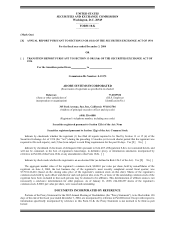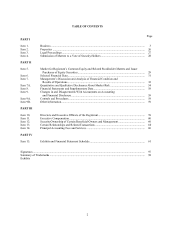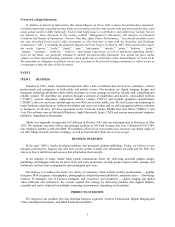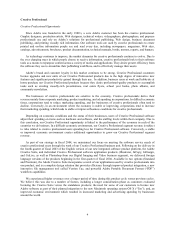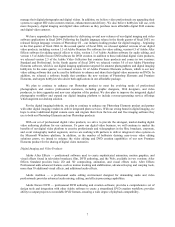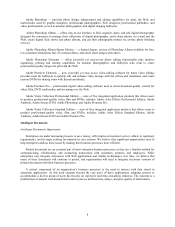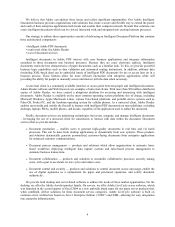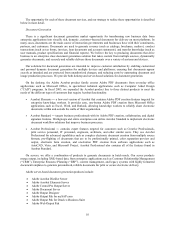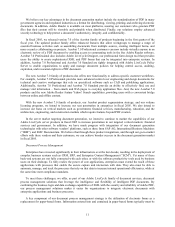Adobe 2004 Annual Report Download - page 4
Download and view the complete annual report
Please find page 4 of the 2004 Adobe annual report below. You can navigate through the pages in the report by either clicking on the pages listed below, or by using the keyword search tool below to find specific information within the annual report.4
Creative Professional
Creative Professional Opportunity
Since Adobe was founded in the early 1980’s, a core Adobe customer has been the creative professional.
Graphic designers, production artists, Web designers, technical writers, videographers, photographers, and prepress
professionals use and rely on Adobe’s solutions for professional publishing, Web design, business document
publishing, and printing visually rich information. Our software tools are used by creative professionals to create
printed and on-line information people see and read every day, including newspapers, magazines, Web sites,
catalogs, advertisements, brochures, product documentation, technical manuals, books, memos, reports, and banners.
As technology continues to improve, the market dynamics for creative professionals continue to evolve. Due to
the ever changing ways in which people choose to receive information, creative professionals look to their software
tools as a means to repurpose content across a variety of media and applications. They desire greater efficiency from
the software they use to streamline their publishing workflows, and to effectively manage their assets.
Adobe’s brand and customer loyalty in this market continues to be strong. Creative Professional customers
license upgrades and new units of our Creative Professional products due to the high degree of innovative new
features and significant productivity gained through their use. In addition, business users at work and hobbyists at
home purchase our Creative Professional products because they desire professional-quality products to accomplish
tasks such as creating visually-rich presentations, real estate flyers, school year books, photo albums, and
community newsletters.
The businesses of creative professionals are sensitive to the economy. Creative professionals derive their
revenue mainly from corporate marketing, product marketing, and ad spending in corporations. In difficult economic
times, corporations tend to reduce marketing spending, and the businesses of creative professionals often tend to
decline. Conversely, in an environment where the economy is stable or improving, corporations tend to increase
their marketing spending, which leads to stable or improved business conditions for creative professionals.
Depending on economic conditions and the status of their businesses, users of Creative Professional software
adjust their spending on items such as hardware and software, and the staffing levels within their company. Due to
this correlation, our Creative Professional opportunity is linked to the performance of the economy in each of the
countries we do business. In a difficult economic environment, our Creative Professional segment revenue is subject
to risks related to creative professional users spending less for Creative Professional software. Conversely, a stable
or improved economic environment creates additional opportunities to grow our Creative Professional segment
revenue.
As part of our strategy in fiscal 2004, we maintained our focus on meeting the software service needs of
creative professional users through the work of our Creative Professional business unit. Following on the delivery in
the fourth quarter of fiscal 2003 of the English version of our new integrated software product platform, the Adobe
Creative Suite, and individual Creative Professional software application products (Illustrator, InCopy, InDesign,
and GoLive, as well as Photoshop from our Digital Imaging and Video business segment), we delivered foreign
language versions of the products beginning in the first quarter of fiscal 2004. Available in two options (Standard
and Premium), the Adobe Creative Suite incorporates several of our applications used by creative professionals into
one product, and is a complete design solution that provides efficiency through improved product integration, a new
innovative file management tool called Version Cue, and powerful Adobe Portable Document Format (“PDF”)
workflow capabilities.
We experienced higher revenues over a longer period of time during this product cycle versus previous cycles.
We believe this was due to a number of factors, including a longer consideration phase as customers evaluated
licensing the Creative Suite versus the standalone products; the need for some of our customers to license new
Adobe software as part of their planned migration to the new Macintosh operating system OS X (“Ten”); and, an
improved economic environment which resulted in increased marketing and advertising spending by businesses
around the world.

